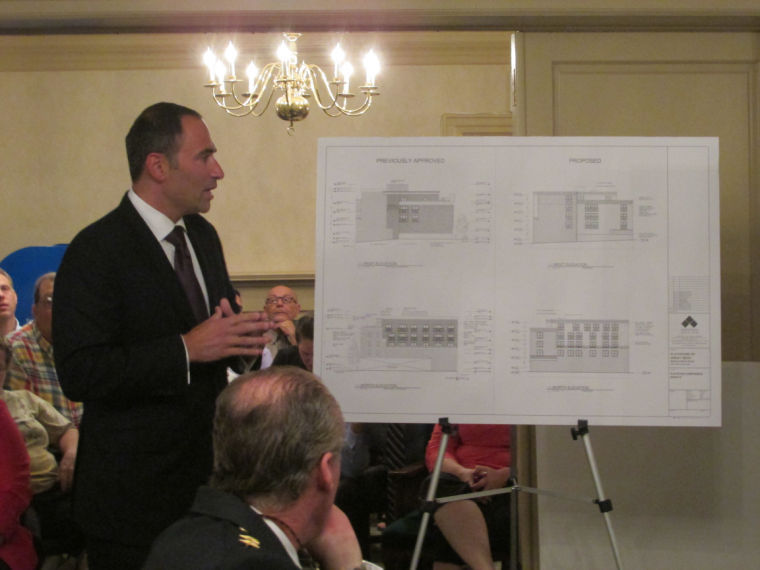Correction: This article misstated the First Playhouse Theater’s location as the corner of Maple Street. It is on the corner of Maple Drive.
The Village of Great Neck Estates Board of Trustees pressed the owners of the historic First Playhouse theater for a more detailed development proposal, as dozens of residents packed Village Hall on Monday to get a first look at revised plans to knock down and rebuild the long-defunct building into luxury apartments.
Village of Great Neck Estates Mayor David Fox emphasized a desire to avoid any lengthy back-and-forth discussion at the meeting and said the village would expect developers to respond to concerns in writing, before presiding over a hearing that saw the board, historical preservationists, adjacent landlords and representatives from the Village of Great Neck Plaza weigh in on the project.
“Site safety is very important to all of us. We all want to see this building rehabilitated and the property brought to fruition so that it’s useable,” Fox said. “It’s been sitting there as a white elephant for a very long time and we’re very fortunate to be able to have someone who wants to do the work.”
The theater, which is located at the corner of Middle Neck Road and Maple Drive, dates back to 1925 and has lain dormant since 1980.
William Bonesso, the attorney representing property owners First Playhouse of Great Neck Corp., said the developers had provided the board with design, site safety and demolition plans, and would give the board the information needed to address its questions.
“We are prepared to provide the board with whatever it deems necessary to address the concerns that were expressed,” Bonesso said.
Among those concerns, said village consultant Edy Zingher, were “insufficient” architectural drawings and demolition and site plans that he estimated were 75 to 80 percent complete and not coordinated with each other.
Bonesso said he believed the project did not yet need full structural plans to proceed, but board members said the planned demolition necessitated a more detailed plan before approval.
Following a series of questions and responses between board members, Bonesso and the project’s architect Brian Newman, Fox recommended that the applicants meet with Zingher and go over specific concerns prior to the next public hearing.
A Manhattan development group announced plans to replace the theater with luxury apartments in 1999 and the villages of Great Neck Estates and Great Neck Plaza have held discussions on the property’s future since 2005.
While previous proposals would have kept the building’s original facade, the current plan calls for a total rebuild with developers saying it would be much more cost-effective to completely rebuild the structure than solely renovate the interior.
Newman, the project’s architect, presented the revised design at the meeting, and said demolition would allow for more flexibility in window placement and parking configurations compared to a solely internal renovation.
Village of Great Neck Estates Historian Ilse Kagan and Great Neck Historical Society President Alice Kasten called for preservation efforts at the meeting.
Kasten, who said her organization has not heard back from the village after sending a letter earlier this year calling for the facade’s preservation, said in an interview that developers should recognize the site’s ties to Great Neck’s show business past.
“This playhouse was the site of performances from a tremendous number of big Broadway names,” Kasten said. “We would love to see it preserved. It’s an important part of Great Neck’s history – it’s too bad it’s not a landmark.”
Kasten suggested at the meeting that the design include a museum to the building’s past, including playbills and other memorabilia from the theater’s heyday.
The playhouse attracted many of the stage’s leading lights in its heyday, including the Marx Brothers, Irving Berlin and Oscar Hammerstein. It also hosted screenings of early Hollywood films, including Lillian Gish vehicle “The Enemy” and Greta Garbo films, according to Kagan.
The Village of Great Neck Plaza also has a stake in the project – while the building lies with Great Neck Estates, the adjacent sidewalk and street fall within Great Neck Plaza.
Village of Great Neck Plaza Mayor Jean Celender laid out her village’s requests, which included monetary compensation for any loss of street parking, assessments of sidewalk damage due to construction, ensuring that temporary walkways meet federal accessibility requirements for the disabled and aesthetically pleasing construction fencing.
“We all need sustainable development to have stave off the increases in costs it takes to run a village,” Celender said. “We don’t take exception to anything that’s being proposed about having a new development but we are very much concerned about how that construction is done.”
The plan also drew concerns over how it could affect nearby business owners.
Village of Great Neck Plaza Trustee Pam Marksheid and the owners of the adjacent building that contains Gino’s Pizzeria asked the developers for reassurances that the construction would not harm the pizzeria’s business.



